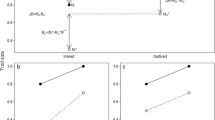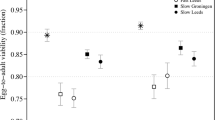Abstract
Deleterious alleles may be removed (purged) bynatural selection in populations undergoinginbreeding. However, there is controversyregarding the effectiveness of selection inreducing the risk of extinction due toinbreeding, especially in relation to the rateof inbreeding. We evaluated the effect of therate of inbreeding on reducing extinction risk,in populations of Drosophila melanogastermaintained using full-sib mating (160replicates), or at effective population sizes(N e) of 10 (80) or 20 (80).Extinction rates in the populations maintainedusing full-sib mating occurred at lower levelsof inbreeding than in the larger populations,whereas the two larger populations did notdiffer significantly from each other.Inbreeding coefficients at 50% extinction were0.62, 0.79 and 0.77 for the full-sib (N e = 2.6), N e = 10 and N e = 20 treatments, respectively. Populations of N e = 20 that remained extant after 60 generations, showed inbreeding depression, with the mean fitness of these populations being only 45% of the outbredcontrols. There was considerable variationamong the 31 inbred populations in fitness, butnone of the N e = 20 populations hadfitness that was higher than the outbredcontrol. We conclude that purging may slow therate of extinction slightly, but it cannot berelied on to eliminate the deleterious effectsof inbreeding.
Similar content being viewed by others
References
Ballou JD (1997) Effects of ancestral inbreeding on genetic load in mammalian populations. J. Hered., 88, 169-178.
Barrett SCH, Charlesworth D (1991) Effects of a change in the level of inbreeding on the genetic load. Nature, 352, 522-524.
Barrett SCH, Kohn JR (1991) Genetic and evolutionary consequences of small population size in plants: Implications for conservation. In: Genetics and Conservation of Rare Plants (eds. Falk DA, Holsinger KE), pp. 3-30. Oxford University Press, Oxford.
Bijlsma R, Bungaard J, van Putten WF (1999) Environmental dependence of inbreeding depression and purging in Drosophila melanogaster. J. Evol. Biol., 12, 1125-1237.
Bowman JC, Falconer DS (1960) Inbreeding depression and heterosis of litter size in mice. Genet. Res. Camb., 1, 262-274.
Brewer BA, Lacy RC, Foster ML, Alaks G (1990) Inbreeding depression in insular and central populations of Peromyscus mice. J. Hered., 81, 257-266.
Brook BW, Tonkyn DW, O'Grady JJ, Frankham R (2002) Contribution of inbreeding to extinction risk in threatened species. Cons. Ecol., 6, 16.
Byers DL, Waller DM (1999) Do plant populations purge their genetic load? Effects of population size and mating history on inbreeding depression. Annu. Rev. Ecol. Syst., 30, 479-513.
Charlesworth D, Charlesworth B (1987) Inbreeding depression and its evolutionary consequences. Ann. Rev. Ecol. Syst., 18, 237-268.
Cornelius PL, Dudley JW (1974) Effects of inbreeding by selfing and full-sib mating in a maize population. Crop Sci., 14, 815-819.
Crnokrak P, Roff DA (1999) Inbreeding depression in the wild. Heredity, 83, 260-270.
Crow JF, Kimura M (1970) An Introduction to Population Genetics Theory. Harper and Row, New York.
Dobson AP, Mace GM, Poole J, Brett RA (1992) Conservation biology: The ecology and genetics of endangered species. In: Genes in Ecology (eds. Berry RJ, Crawford TJ, Hewitt GM), pp. 405-430. Blackwell, Oxford.
dos Santos EM, Andreassen HP, Ims RA (1995) Differential inbreeding tolerance in two geographically distinct strains of root voles, Microtus oeconomus. Ecography, 18, 238-247.
Dudash MR, Carr DE, Fenster CB (1997) Five generations of enforced selfing and outcrossing in Mimulus guttatus: Inbreeding depression variation at the population and family level. Evolution, 51, 54-65.
Ehiobu NG, Goddard ME, Taylor JF (1989) Effect of the rate of inbreeding on inbreeding depression in Drosophila melanogaster. Theor. Appl. Genet., 77, 123-127.
Falconer DS (1960) The genetics of litter size in mice. J. Cell. Comp. Phys., 56, 153-167.
Falconer DS, Mackay TFC (1996) Introduction to Quantitative Genetics, 4th ed. Longman Scientific &; Technical, Burnt Mill, Harlow, England.
Frankel OH, Soulé ME (1981) Conservation and Evolution. Cambridge University Press, Cambridge.
Frankham R (1995a) Inbreeding and extinction: a threshold effect. Conserv. Biol., 9, 792-799.
Frankham R (1995b) Effective population size / adult population size ratios in wildlife: a review. Genet. Res., 66, 95-107.
Frankham R (2000) Modeling problems in conservation genetics using laboratory animals. In: Quantitative Methods in Conservation Biology (eds. Ferson S, Burgman M), pp. 259-273. Springer-Verlag, New York.
Frankham R, Ballou JD, Briscoe DA (2002) Introduction to Conservation Genetics. Cambridge University Press, Cambridge, England.
Frankham R, Gilligan DM, Morris D, Briscoe DA (2001) Inbreeding and extinction: Effects of purging. Conserv. Genet., 2, 279-285.
Frankham R, Yoo BH, Sheldon BL (1988) Reproductive fitness and artificial selection in animal breeding: Culling on fitness prevents a decline in reproductive fitness in lines of Drosophila melanogaster selected for increased inebriation time. Theor. Appl. Genet., 76, 909-914.
Good RL, Hallauer AR (1977) Inbreeding depression in maize by selfing and full-sibbing. Crop Sci., 17, 935-940.
Hedrick PW (1994) Purging inbreeding depression and the probability of extinction: Full-sib mating. Heredity, 73, 363-372.
Hedrick PW, Kalinowski ST (2000) Inbreeding depression in conservation biology. Annu. Rev. Ecol. Syst., 31, 139-152.
Husband BC, Schemske DW (1996) Evolution of the magnitude and timing of inbreeding depression in plants. Evolution, 50, 54-70.
Keller LF, Waller DM (2002) Inbreeding effects in wild populations. Trends Ecol. Evol., 17, 230-241
Lacy RC, Ballou JD (1998) Effectiveness of selection in reducing the genetic load in populations of Peromyscus polionotus during generations of inbreeding. Evolution, 52, 900-909.
Lacy RC, Alaks G, Walsh A (1996) Hierarchical analysis of inbreeding depression in Peromyscus polionotus. Evolution, 50, 2187-2200.
Laikre L, Ryman N, Thomson EA (1993) Hereditary blindness in a captive wolf (Canis lupus) population: Frequency reduction of a deleterious allele in relation to gene conservation. Conserv. Biol., 7, 592-601.
Lande R, Schemske DW (1985) The evolution of self-fertilization and inbreeding depression in plants. I. Genetic models. Evolution, 39, 24-40.
Latta R, Ritland K (1994) The relationship between inbreeding depression and prior inbreeding among populations of four Mimulus taxa. Evolution, 48, 806-817.
Latter BDH, Mulley JC, Reid D, Pascoe L (1995) Reduced genetic load revealed by slow inbreeding in Drosophila melanogaster. Genetics, 139, 287-297.
Latter BDH, Robertson A (1962) The effects of inbreeding and artificial selection on reproductive fitness. Genet. Res. Camb., 3, 110-138.
Lynch M, Walsh B (1998) Genetics and Analysis of Quantitative Traits. Sinauer, Sunderland, MA.
Mayer SS, Charlesworth D, Meyers B (1996) Inbreeding depression in four populations of Collinsia heterophylla Nutt (Scrophulariaceae). Evolution, 50, 879-891.
McCall C, Waller DM, Mitchell-Olds T (1994) Effects of serial inbreeding on fitness components in Impatiens capensis. Evolution, 48, 818-827.
Mills LS, Smouse PE (1994) Demographic consequences of inbreeding in remnant populations. Amer. Nature, 144, 412-431.
Newman D, Pilson D (1997) Increased probability of extinction due to decreased genetic effective population size: Experimental populations of Clarkia pulchella. Evolution, 51, 354-362.
Oostermeijer JGB (2000) Population viability analysis of the rare Gentiana pneumonanthe: the importance of genetics, demography and reproductive biology. In: Genetics, Demography and Viability of Fragmented Populations (eds. Young AG, Clarke GM), pp. 313-334. Cambridge University Press, Cambridge, U.K.
Pray LA, Goodnight CJ (1995) Genetic variation in inbreeding depression in the red flour beetle Tribolium castaneum. Evolution, 49, 176-188.
Ralls K, Ballou J (1983) Extinction: Lessons from zoos. In: Genetics and Conservation: A Reference for Managing Wild Animal and Plant Populations (eds. Schonewald-Cox CM, Chambers SM, MacBryde F, Thomas L), pp. 125-151. Benjamin / Cummings, Merlo Park, CA.
Ralls K, Ballou JD, Templeton A (1988) Estimates of lethal equivalents and the cost of inbreeding in mammals. Conserv. Biol., 2, 185-193.
Reed DH (1998) Population Size, Selection, and Mutation Accumulation. Ph.D. dissertation. University of Houston, Texas.
Reed DH, Bryant EH (2001) Fitness, genetic load and purging in experimental populations of the housefly. Conserv. Genet., 2, 57-62.
Reed DH, Bryant EH (2000) Experimental tests of minimum viable population size. Anim. Conserv., 3, 7-14.
Reed DH, Frankham R (2003) Fitness is correlated with genetic diversity. Conserv. Biol., 17: 1-9.
Reed DH, Frankham R (2002) Inbreeding and extinction: the effect of environmental stress and lineage. Conserv. Genet., 3, 301-307.
Saccheri I, Kuussaari M, Kankare M, Vikman P, Fortelius W, Hanski I (1998) Inbreeding and extinction in a butterfly metapopulation. Nature, 392, 491-494.
Shields WM (1993) The natural and unnatural history of inbreeding and outbreeding. In: The Natural History of Inbreeding and Outbreeding (ed. Thornhill NW), pp. 143-169. University of Chicago Press, Chicago.
Sokal RR, Rohlf FJ (1995) Biometry, 3rd edition. W. H. Freeman and Company, New York.
Tantawy AO (1952) Changes in genetic variability with different intensities of inbreeding. Dros. Inf. Serv., 26, 123-125.
Tantawy AO (1957a) Genetic variance of random inbred lines of Drosophila melanogaster in relation to coefficients of inbreeding. Genetics, 42, 121-136.
Tantawy AO (1957b) Heterosis and genetic variance in hybrids between inbred lines of Drosophila melanogaster in relation to the level of heterozygosity. Genetics, 42, 535-543.
Templeton AR, Read B (1984) Factors eliminating inbreeding depression in a captive herd of Speke's gazelle (Gazella spekei). Zoo Biol., 3, 177-199.
Wang J, Hill WG, Charlesworth D, Charlesworth B (1999) Dynamics of inbreeding depression due to the deleterious mutations in small populations: Mutation parameters and inbreeding rates. Genet. Res. Camb., 74, 165-178.
Westermeier RL, Brawn JD, Simpson SA, Esker TL, Jansen RW, Walk JW, Kershner EL, Bouzat JL, Paige KN (1998) Tracking the long-term decline and recovery of an isolated population. Science, 282, 1695-1698.
Wright, S (1977) Evolution and the Genetics of Populations, Volume 3. Experimental Results and Evolutionary Deductions. University of Chicago Press, Chicago.
Author information
Authors and Affiliations
Corresponding author
Rights and permissions
About this article
Cite this article
Reed, D.H., Lowe, E.H., Briscoe, D.A. et al. Inbreeding and extinction: Effects of rate of inbreeding. Conservation Genetics 4, 405–410 (2003). https://doi.org/10.1023/A:1024081416729
Issue Date:
DOI: https://doi.org/10.1023/A:1024081416729




